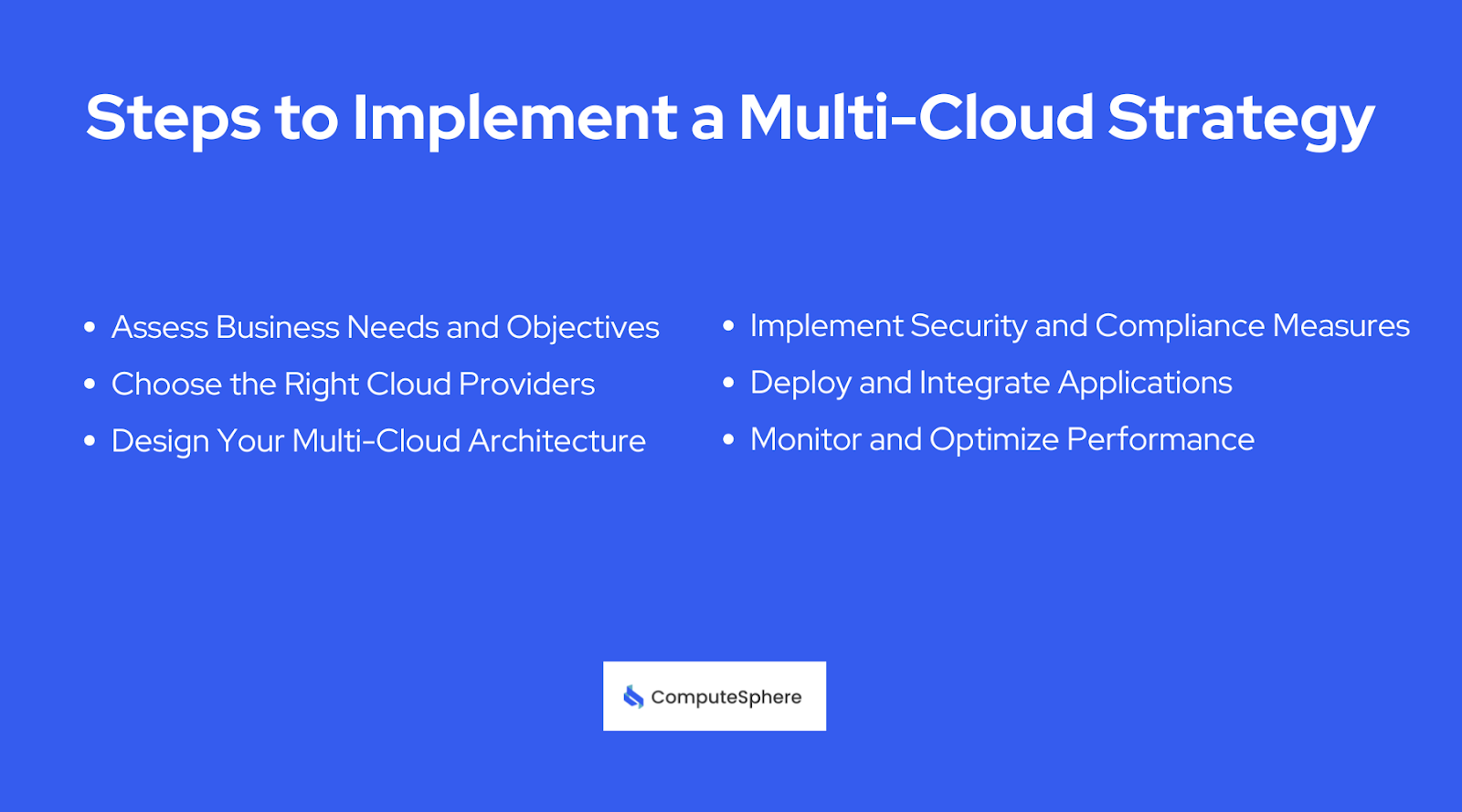How to Implement a Multi-Cloud Strategy? A Comprehensive Guide for Businesses

Businesses need IT systems that are flexible, reliable, and cost-effective. A multi-cloud strategy using cloud services from different providers helps achieve these goals by making operations more agile and reducing dependency on a single vendor. By spreading workloads across various cloud platforms, companies can manage resources better, improve disaster recovery, cut costs, and avoid vendor lock-in. However, implementing this strategy requires careful planning.
The article provides a step-by-step guide to successfully implementing a multi-cloud strategy, describing the benefits and challenges of such a strategy.
Benefits of a Multi-Cloud Strategy
A multi-cloud strategy can be a game-changer for you and your business, offering several significant benefits:
Improved Flexibility and Scalability:
You can easily scale your resources up or down by leveraging multiple cloud providers based on demand. This flexibility allows you to manage workloads more effectively and handle sudden spikes in traffic or usage without a hitch.
Enhanced Disaster Recovery and Business Continuity:
Distributing your data and applications across various clouds ensures that a failure in one provider won’t disrupt your entire operation. This redundancy is crucial for maintaining business continuity and protecting your critical assets.
Cost Optimization and Competitive Pricing
Utilizing multiple cloud services lets you choose the most cost-effective solutions for different workloads. You can take advantage of competitive pricing and avoid being locked into a single vendor’s pricing structure, ultimately saving you money.
Avoiding Vendor Lock-In:
Depen on a single cloud provider can create dependencies that are hard to break. A multi-cloud approach mitigates this risk by diversifying your cloud ecosystem, giving you more negotiating power and the freedom to switch providers if needed.
Challenges of Implementing a Multi-Cloud Strategy
Implementing a multi-cloud strategy offers many benefits but presents several challenges.
Managing multiple cloud environments increases complexity. You need stable governance policies and tools to ensure smooth operation.
Different cloud providers have varying security and compliance standards. Ensuring consistent security measures across all platforms is essential.
Integrating data and applications across multiple clouds can be difficult due to differing architectures and APIs. Ensuring smooth interoperability is crucial for effective operations.
Tracking and optimizing costs across multiple providers is difficult. You must use tools and strategies to manage spending efficiently.
Steps to Implement a Multi-Cloud Strategy

By implementing a multi-cloud strategy, your business can significantly improve its flexibility, reliability, and cost efficiency. Throughout the process, follow these steps:
1. Assess Business Needs and Objectives
Identify your business goals and requirements. Determine what you want to achieve with a multi-cloud strategy, such as improving performance, reducing costs, or enhancing resilience. Assess your existing infrastructure and applications to ensure they are compatible with a multi-cloud approach.
2. Choose the Right Cloud Providers
Compare different cloud service providers based on your specific needs. Consider factors like performance, pricing, security features, and geographical coverage. Popular choices include AWS for its extensive services, Azure for integration with Microsoft products, and Google Cloud for data analytics and machine learning. Select providers that best align with your business objectives.
3. Design Your Multi-Cloud Architecture
Create a detailed architecture plan outlining how you will distribute your applications and services across different clouds. Ensure compatibility and integration by standardizing APIs and using containerization technologies like Docker and Kubernetes. This step is crucial for seamless integration and efficient management.
4. Implement Security and Compliance Measures
Establish comprehensive security protocols that apply uniformly across all cloud environments. Implement identity and access management (IAM) policies, encryption standards, and regular security audits. Work closely with your legal and compliance teams to ensure adherence to industry regulations such as GDPR or HIPAA.
5. Deploy and Integrate Applications
Migrate and deploy your applications across the chosen cloud platforms. Use orchestration tools to manage the deployment process and ensure proper configuration for each environment. Aim for seamless integration with limited interruption to your operations.
6. Monitor and Optimize Performance
Set up monitoring tools and dashboards to track the performance of your multi-cloud environment. Regularly review these metrics to identify areas for improvement. Optimize resource allocation, scaling, and costs based on real-time data and performance insights
Best Practices for Managing a Multi-Cloud Environment
Centralized Management and Automation
Use centralized management tools to oversee your entire multi-cloud environment. Automation can help reduce the complexity of managing multiple platforms by streamlining routine tasks such as provisioning, scaling, and updates.
Regularly Reviewing and Updating Security Policies.
Security threats constantly evolve, and so should your security policies. Regularly review and update your security measures to ensure they remain effective. Conduct periodic security audits and vulnerability assessments to identify and address potential risks.
Implementing a Robust Data Management Strategy
A solid data management strategy is essential for ensuring data consistency and integrity across multiple clouds. Use data integration tools and practices such as ETL (extract, transform, load) processes to maintain synchronized and accurate data.
Training and Upskilling IT Staff
Provide your IT staff with the necessary skills to manage a multi-cloud environment effectively. Provide training on the specific tools and technologies used in your multi-cloud strategy. Upskilling your team ensures they can handle the complexities and challenges of a multi-cloud setup.
Tools and Technologies for Multi-Cloud Management
There are several tools and technologies available to assist in managing a multi-cloud environment:
Cloud Management Platforms (CMPs): CMPs provide a unified interface for managing multiple cloud services. They help with provisioning, monitoring, and optimizing resources across different clouds. Examples include RightScale, Scalr, and CloudBolt.
Monitoring and Analytics Tools: Tools like New Relic, Datadog, and Splunk offer comprehensive monitoring and analytics capabilities. They help track performance, identify issues, and provide insights for optimization.
Security and Compliance Tools: Solutions like Palo Alto Networks, Fortinet, and AWS Security Hub offer advanced security features tailored for multi-cloud environments. These tools ensure consistent security and compliance across all cloud platforms.
Conclusion
A multi-cloud strategy can improve your business's flexibility, reliability, and cost-effectiveness. You can successfully manage a multi-cloud environment by evaluating your needs, selecting the right providers, and following best practices. Using centralized management tools, keeping security measures up-to-date, and training your IT team will help you handle this diverse setup. Start planning your multi-cloud strategy today to enjoy the benefits of a strong, scalable, and adaptable cloud infrastructure.
Contents
Built for Builders. Priced for Startups.
Tired of unpredictable cloud bills? ComputeSphere offers modular, fixed-cost cloud hosting that grows with your startup—no DevOps headaches, no surprises.
Get StartedShare this article
Browse Some Related Blogs
Relevant and related contents you can read









